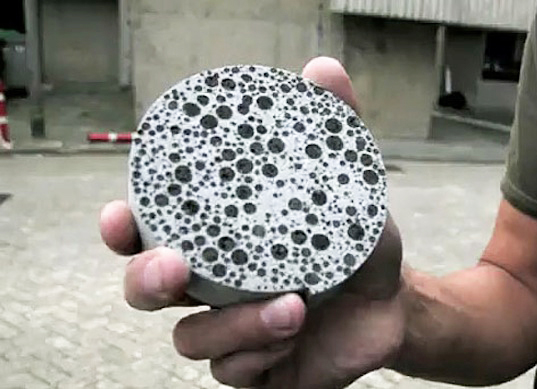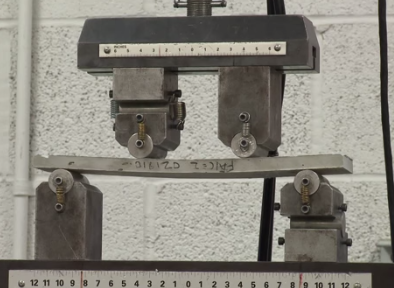by
[user not found]
| Jun 23, 2015
Concrete: the rock solid material that makes up our bridges, buildings, sidewalks, streets and more. This remarkable building material has become a construction staple for it’s low cost to put together and ability to mold into just about any shape.
That is until the last 15 years or so. As science and technology move faster and faster and steady innovation and iteration become the norm, concrete is another innovation due for a modernization.
Here are 3 emerging trends on the way for concrete and concrete technology.
1. Self-Repairing Concrete
Structures made from concrete. is subject to the elements. Wind, rain, freeze-thaw cycles all play a role in affecting the lifespan of concrete. Cracks and chipping are going to occur and when that happens, towns and cities tend to set aside funds to rebuild or repair their crumbling infrastructure or engage in a whole new public works project.
a role in affecting the lifespan of concrete. Cracks and chipping are going to occur and when that happens, towns and cities tend to set aside funds to rebuild or repair their crumbling infrastructure or engage in a whole new public works project.
Cracking concrete isn't a new issue, but it's one that has continued to jeopardize concrete's longevity. Cracks lead to water seepage and the leaking water can wear away concrete. Additionally, if concrete is reinforced with rebar the rebar can corrode away and the concrete structure's integrity can fall apart.
In the face of this reality, the question must be asked: is a future around the corner where buildings will be able to repair themselves? It would certainly look like that.
Bioconcrete is among the latest developments for concrete. Bioconcrete is concrete made with a special bacteria called Bacillus genus and bacteria-supportive nutrients and supplements.
One CNN profile piece explains how bacteria is used to heal concrete:
"The bacteria then germinate, multiply and feed on the lactate, and in doing so they combine the calcium with carbonate ions to form calcite, or limestone, which closes up the cracks."
According to Henk Jonkers and Eric Schlangen of the Delft Technical University in the Netherlands, "[bioconcrete has] been able to heal cracks up with a width of .5mm." The concept of self-healing concrete and bacteria-infused building material is relatively new, but Jonkers and Schlangen are beginning to take their experiment out fo the lab.
The two are experimenting with how the concrete survives for prolonged periods of time outdoors, how the concrete works with larger projects like sidewalks and buildings and if costs can be reduced to produce it en masse.
2. Smog Eating Concrete
Roads are not going away and cars are certainly becoming cleaner and more environmentally conscious, but there is still a ways to go when it comes to totally environmentally sound travel and transit. Imagine for a minute if the roads themselves could soak up carbon dioxide and other greenhouse gasses emitted by cars, trucks and busses passing over the miles of interstate that connect the United States. Smog eating concrete is the unofficial name of a special kind of concrete called photocatalytic concrete.
Photocatalytic concrete contains special nano particles of titanium dioxide that 'eat' smog by removing the nitrogen oxide gasses from the surrounding air and expelling hydrogen dioxide in its place. This kind of concrete was first implemented across Chicago's 2-mile long Cermak Road and Blue Island Avenue in the town's Pilsen neighborhood and accompanying sidewalks and later in Houston, Texas.
The places paved with the photocatalytic concrete found a 19 percent reduction in nitrogen oxide air pollution over the average day along the road. Ideally, reduction could reach 45 percent, according to one Chron piece.
While self-healing and bendable concrete seem to have been receiving abundant funding for further research over the years, smog eating concrete hasn't as one Motherboard article points out.
From the article:
"'I’ve been working on it for 20 years,” said Italian chemist Luigi Cassar, the inventor of smog-eating concrete. “Not everyone will invest in the research.'
While with the Italcementi Group, Cassar first invented smog-eating concrete back in the 1990s. The first building was completed in 2000 by architect Richard Meier, while the smog-eating product hit the market in 2006 as TxActive. Today, anywhere between 20 and 50 buildings have been built with smog-eating concrete."
3. Bendable Concrete
Imagine a block of concrete.
Now imagine some of its qualities. Heavy, grey, tough might be some of the words that come to mind when you think of a concrete block. But probably not bendable.
As it turns out, one team of researchers is out to make concrete less of a rigid building material and more of an uncharacteristically flexible one.
Researcher Victor Li of the University of Michigan has been the forerunner in uncovering the possibilities of a bendable, flexible concrete. Li's research lead him to a concrete he has called Engineered Cementitious Concrete or ECC for short.
Unlike regular concrete which turns brittle when hardened and is vulnerable to cracking and breaking, ECC provides give when a load is imparted onto it adding almost "300 times the bendability" of regular concrete. "The concrete behaves plastically - gives and flexes and holds a load. It bends but doesn't break," Dr. Li explains in a short feature piece from the University of Michigan's civil engineering department.
 The secret of ECC comes from coated microscopic fibers. The fibers are built to share the weight of the load and disperse the weight. As the weight is imparted on the concrete, tiny hairline cracks form "about the width of a human hair", rather than a small series of large cracks. The hairline cracks allow the concrete to yield to the weight without ever failing.
The secret of ECC comes from coated microscopic fibers. The fibers are built to share the weight of the load and disperse the weight. As the weight is imparted on the concrete, tiny hairline cracks form "about the width of a human hair", rather than a small series of large cracks. The hairline cracks allow the concrete to yield to the weight without ever failing.
ECC concrete can also ensure outward stress when steel rebar rusts and corrodes. When steel rebar rusts, expands outward and causes concrete to break apart and fracture - a very common issue on bridge decks. ECC, according to Li, can endure the outward force exerted by the rusting steel and won't crack.